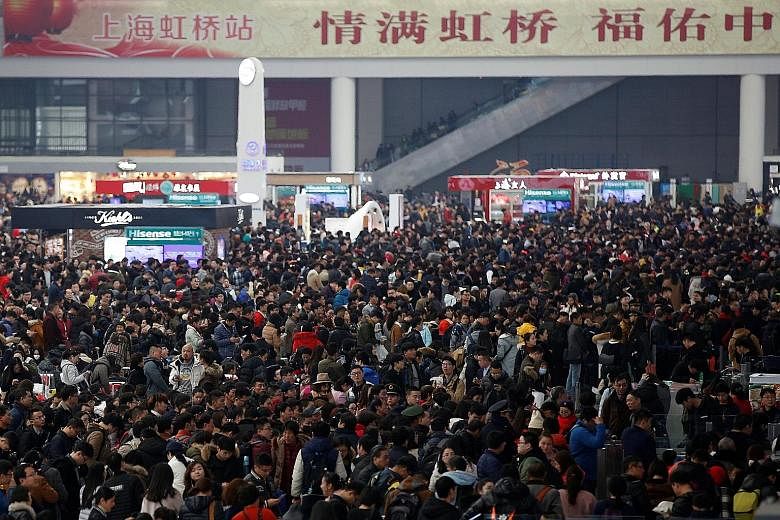BEIJING • Ms Shi Ying, 30, will not be making the traditional pilgrimage back to Shanghai to celebrate the Chinese New Year holiday with her extended family.
Instead, they are all going to Japan for shopping and sightseeing.
The new practice lets her family bypass the crowds, clogged roads and subways, lousy customer service and boredom that can mark holidays at home.
For the past few celebrations, Ms Shi and her relatives left China for Singapore, Malaysia, Thailand and the United States.
"The last thing my parents want for Chinese New Year is a cheerless holiday with the three of us staying at home in Shanghai," said Ms Shi, who works for a non-governmental organisation in Beijing.
"Going overseas during the Spring Festival costs about the same as going to some domestic tourist spots."
The essence of China's seven-day holiday, also called the Spring Festival, is morphing as rising incomes and an expanding network of international flights prompt more people to go abroad - the equivalent of Americans choosing Bermuda over the Midwest for Thanksgiving.
Outbound travel for the holiday break is expected to top a record six million passengers, with airlines hauling near-full loads to Japan, South Korea and South-east Asia.
"Chinese New Year is a major international peak for the Chinese airlines," said Mr Steve Saxon, a Shanghai-based partner at consultant McKinsey & Co.
"For many, this is one of the only two opportunities to take a long holiday during the year."
The Spring Festival shuts down the world's second biggest economy for a week as hundreds of millions of factory and office workers leave their adopted homes in Shenzhen or Beijing to reconnect with their ancestral ones, often on the opposite side of the country.
This year's celebration, from Jan 27 through Feb 2, will see the biggest mass migration of people on earth. More than 414 million Chinese will ride in planes and trains, almost equivalent to everyone in the European Union being on the move.
About 58.3 million people are expected to fly, representing a 10 per cent increase from last year, according to estimates by the Civil Aviation Administration of China.
Chinese airlines generate about 20 per cent of their revenue during this period, Mr Saxon said.
The Chinese will travel to 174 destinations outside mainland China for an average of 9.2 days during the holiday period, according to online travel service Ctrip.com International.
"Any airline should be able to swim in money during a Chinese travelling holiday," said Mr Will Horton, a Hong Kong-based analyst at Capa - Centre for Aviation.
Fuelling those excursions is an economy growing annually by at least 6.7 per cent since 1990, giving people more money to spend. Disposable income for urban households rose 165 per cent from 2006 to 2015, reaching about 31,195 yuan (S$6,440), according to China's National Bureau of Statistics.
China is the biggest source of overseas travellers in the world, with 128 million people spending US$292 billion (S$415 billion) on their trips in 2015, according to the World Tourism Organisation.
That has been a boon to the nation's airlines, with demand running so high that discounts are ending as early as 50 days before take-off, according to Ctrip.com.
The top-dollar tickets help carriers make up for the massive price cuts offered during slow seasons.
Meanwhile, Japan, Australia and even Israel are rolling out the welcome mats for Chinese tourists by offering multiple-year, multiple-entry visas to Chinese passport holders.
The United Arab Emirates is going a step further by offering visas upon arrival, according to state-run Sinai News Agency.
Ms Shi's family will fly to Japan on Jan 27 for a seven-day trip to Kyoto and Tokyo. Besides the tourist attractions, they plan on some serious shopping for cosmetics, clothes, rice cookers and high-tech toilet seats.
"My parents really get a kick out of travelling during Chinese New Year," she said. "Let's hope I can cap my spending for the whole trip at 80,000 yuan."
BLOOMBERG

